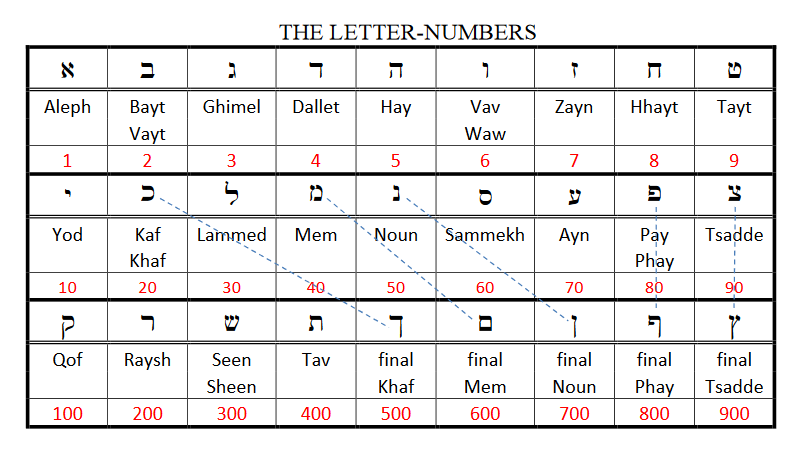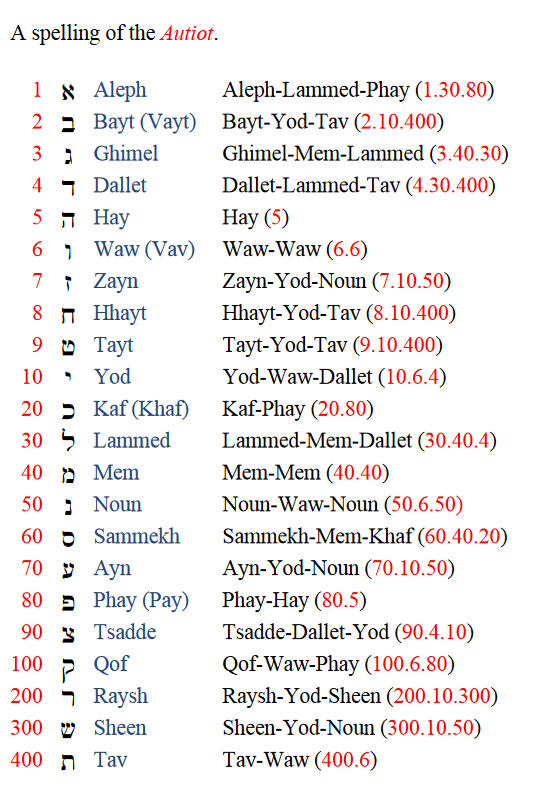
HyperText Hebrew Alphabet
|
Chapter 3 of The Cipher of Genesis by Carlo Suares, Weiser, 1970 "The Letter-Numbers"Let us now concern ourself with the individual Hebrew letter-numbers according to the code.  The first nine letters are the archetypes of numbers from 1 to 9.
The first nine letters are the archetypes of numbers from 1 to 9.Aleph, no. 1, is the unthinkable life-death, abstract principle of all that is and all that is not. Bayt (or Vayt), no. 2, is the archetype of all "dwellings", of all containers: the physical support without which nothing is. Ghimel, no. 3, is the organic movement of every Bayt animated by Aleph. Dallet, no. 4, is physical existence, as response to life, of all that, in nature, is organically active with Ghimel. Where the structure is inorganic Dallet is its own resistance to destruction. Hay, no. 5, is the archetype of iniversal life. When it is conferred upon Dallet, it allows it to play the game of existence, in partnership with the intermittent life-death process. Vav (or Waw), no. 6 expresses the fertilizing agent, that which impregnates. It is the direct result of Hay upon Dallet. Zayn, no. 7, is the achievement of every vital impregnation: this number opens the field of every possible possbility. Hayt, no. 8, is the sphere of storage of all undifferentiated energy, or unstructured substance. It expresses the most un-evolved state of energy, as opposed to its achived freedom in Zayn. Tayt, no. 9, as archeytpe of the primeval female energy, draws its life from Hayt and builds it gradually into structures. Such is the fundamental equations set and developed in Genesis. The following nine letters, from Yod no. 10 to Tsadde no. 90, describe the process of the nine archetypes in their factual, conditioned existence: their projections in manifestation are always multiples of 10. The nine multiples of 100 express the exalted archetypes in their cosmic states. The number 1000, is written with an enlarged Aleph (Aleph, in Hebrew actually means a thousand), but is seldom used. It expresses a supreme power, a tremendous cosmic energy, all-pervading, timeless, unthinkable. The study of those multiples by 10 and by 100 is therefore the study of the very archetypes in their various spheres of emanation. The student will find it useful to examine them, so to say, vertically,: 1.10.100-2.20.200... and so on. The choice for Kaf (20) for 500, of Mem (40) for 600, and of Noun (50) for 700 in finals of schemata means that those numbers acquire such cosmic values when they unfold in human beings. Thus: Adam is 1.4.40 when immature and achieves 1.4.600 when attaining his full maturity. Here is a brief general view of the relationship between the archetypes and their multiples: Aleph-Yod-Qof (1.10.100): Whereas Aleph (1) is the beat, or pulsation of life-death-life-death, Yod (10) is its projection in temporal continuity. So Yod (in Hebrew: the hand), is the opposite of Aleph, its partner playing against it the game without which nothing would be. The Qof (100) is the most difficult symbol to understand. It includes Aleph exalted in its principle yet acting through its projection, against itself, and thereby being cosmically deathless. It is best seen in Qaheen (Cain) that mythical destroyer of illusions. Bayt-Kaf-Raysh (2.20.200): Whereas Bayt (2), the archetype of all containers, has its roots in the cosmic resistance to life, Kaf (20) -- in Hebrew, the hollow of the hand -- is ready to receive all that comes and Raysh (200), the cosmic container of all existence, has its roots in the intense organic movement of the universe. Ghimel-Lammed-Sheen (3.30.300): these three letter-numbers express a movement in progressive enlargement, from the uncontrolled functional action of Ghimel (2), through the controlled connecting agent Lammed (30), going as far as the universal Sheen (300), mythically considered to be the "spirit", of "breath" of God. Dallet-Mem-Tav (4.40.400): the physical resistance of structures, Dallet (4) finds its purveyor in the maternal waters, Mem (40), where all life originates. Tav (400) is the exaltation of the entire cosmic existence in its utmost capacity to resist to life-death. The root Dallet-Mem (Dam) is "blood" in Hebrew and the root Mem-Tav (Met) is "death." Thus the two together express the complete cycle of existence. Hay-Noun-Kaf in finals (5.50.500): the universal life, Hay (5) is condensed in individual existences as Noun (50) and is exalted cosmically as Kaf (500) in terminals. Waw-Sammekh-Mem in finals (6.60.600): Waw (6) is the male agent of fertility, Sammekh (60) is the female. Mem when in terminals (600) is the cosmic achievement of fruitfulness both in the intelligent or immaterial part of man and in the flesh. In Hebrew, Waw maintains its character grammatically as copulative or connecting agent. Zayn-Ayn-Noun in finals (7.70.700): Zayn (7) as an opening towards all possible possibilities has its source and its vision in Ayn (70), which is the word for "eye" in Hebrew. Its is exalted in Noun (700): this number expresses the very principle contended for in the interplay of energies thoughout the universe: the principle of indetermination in which life itself is at stake. Here we find Cain again. Hhayt-Pay-Phay in finals (8.80.800): in every sphere of the emanation, from the densest to the most rarefied essence, these numbers stand for the primordial substance, the unfathomed reserve of undifferentiated, unstructured energy. Tayt-Tsadde-Tsadde in finals (9.90.900): these ideograms express a progression ascending from the simplest and most primative cell (or female structural energy) up to the transfigured symbols of womanhood, social and mythical. 
[See PDF above for Hebrew Letters not shown.] Thus the language of this text is as complex as life itself, and yet the vital experience which can result from the full perception of it has the simplicity and immediacy of a revelation. The difficulty for the writer will be to elucidate for his readers a text in a language which they do not know, and the difficulty for his readers will be to be compelled to enter into this language before having learned it. In fact, it is a language to be entered into and not to be learned. Its impact is direct, instantaneous and total if we meet it with a mind completely void and are willing to listen to a story which was originally intended to convey something altogether different from what we are conditioned to believe. In the original meaning, there is no reference to a personal God; woman does not issue from a rib of Adam; she is not called Eve in the Garden of Eden; she does not disobey; there is no question of sin; the woman is not expelled from Eden; Cain does not kill Abel; he is not cursed by a divinity, but on the contrary protected; and if we jump a few hundred centuries to enter the allegory of Yhshwh, better known as Jesus, we find that the only Apostle who aided him in the fulfilment of his enterprise was called Judas. Such statements are no doubt surprising, but it is not generally realized to what extent the notions that Eve disobeyed, that Cain killed Abel and that Judas was a traitor have poisoned the mind. In a fundamental respect, these distortions are still contributing to the emotional illness and psychological disorders of the present day world. This and many other such misunderstandings have been brought about by an erroneous way of thinking which, since the dawn of history, it has been the general custom of mankind to follow. This way of thinking involves a usage of words whose meaning it is not possible to conceive. It gave birth to all of the early deities, as well as the latest and the most elaborate theologies. Whereas rational thought cannot but be confined within the field of time and measurement, comparison and evaluation, this erroneous thinking (as already pointed out) makes use of such exalted words as immortality, eternity, absolute, Godand innumerable other vague and emotional projections. The language we need to use in rereading the Book of Genesis should preclude all such errors. We shall be careful never to use a word unless its full meaning is clearly grasped. We shall hold to plain common sense and factual statements in order to keep our balance during an exploration which will cut across many deep-rooted fixations in "the thoughts of man." See: Hypertext Hebrew Alphabet | Comparative Semantics/Numerology of the Hebrew Alphabet | Qaheen/Cain | The Cipher of Genesis Tree 2 / duversity.org |
| 22 Autiot Yassod + Finals | ||||||||
 |
 |
 |
 |
 |
 |
 |
 |
 |
 |
 |
 |
 |
 |
 |
 |
 |
 |
 |
 |
 |
 |
 |
 |
 |
 |
 |
| Hypertext Hebrew Alphabet | ||||||||